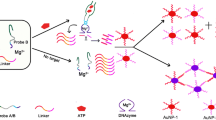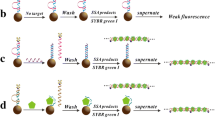Abstract
We report on a fluorescence polarization assay for the detection of the target analyte ATP by making use of an aptasensor and of mass-amplifying CdTe-CdS quantum dots. The ATP aptamer was modified with digoxin antigen and hybridized with its complementary DNA that was modified with the CdTe-CdS quantum dots. Following the addition of digoxin antibody, the mass-amplifying aptasensor probe is formed as a result of the immuno reaction. In the presence of ATP, the polarization of fluorescence decreases because the digoxin antibody becomes dissociated due to the recognition of the ATP by the ATP aptamer. Under optimized conditions, the method has a linear response to ATP in the 10 to 350 μM concentration range, and the limit of detection is 3.7 μM. The method combines the specific recognition capability of aptamers with the sensitivity of an immunoreaction. It has good selectivity and sensitivity, and can be used to detect ATP in serum samples.









Similar content being viewed by others
References
Freeman R, Girsh J, Jou AFJ, Ho JA, Hug T, Dernedde J, Willner I (2012) Optical aptasensors for the analysis of the vascular endothelial growth factor (VEGF). Anal Chem 84(14):6192–6198
Gang-Il K, Kyung-Woo K, Min-Kyu O, Yun-Mo S (2009) The detection of platelet derived growth factor using decoupling of quencher-oligonucleotide from aptamer/quantum dot bioconjugates. Nanotechnology 20:175503
Cuiping M, Wenshuo W, Qing Y, Chao S, Lijie C (2011) Cocaine detection via rolling circle amplification of short DNA strand separated by magnetic beads. Biosens Bioelectron 26:3309–3312
Boeneman K, Prasuhn DE, Blanco-Canosa JB, Dawson PE, Melinger JS, Ancona M, Stewart MH, Susumu K, Huston A, Medintz IL (2010) Self-assembled quantum dot-sensitized multivalent DNA photonic wires. J Am Chem Soc 132(51):18177–18190
Feng X, Xiaoteng L, I-Ming H (2012) Ultrasensitive solution-phase electrochemical molecular beacon-based DNA detection with signa amplification by Exonuclease III-assisted target recycling. Anal Chem 84:5216–5220
Gasparac R, Taft BJ, Lapierre-Devlin MA, Lazareck AD, Xu JM, Kelley SO (2004) Ultrasensitive electrocatalytic DNA detection at two- and three-dimensional nanoelectrodes. J Am Chem Soc 126(39):12270–12271
Wang J, Liu G, Merkoçi A (2003) Electrochemical coding technology for simultaneous detection of multiple DNA targets. J Am Chem Soc 125(11):3214–3215
Chunwei C, Yehhsing L, Yishan L, Linchi C (2011) A quantum dot-aptamer beacon using a DNA intercalating dye as the FRET reporter: application to label-free thrombin detection. Biosens Bioelectron 26:3346–3352
Ellington AD, Szostak JW (1990) In vitro selection of RNA molecules that bind specific ligands. Nature 346(6287):818–822
Tuerk C, Gold L (1990) Systematic evolution of ligands by exponential enrichment: RNA ligands to bacteriophage T4 DNA polymerase. Science 249(4968):505–510
Gold L, Polisky B, Uhlenbeck O, Yarus M (1995) Diversity of oligonucleotide functions. Annu Rev Biochem 64:763–797
Li M, Wang QY, Shi XD, Hornak LA, Wu NQ (2011) Detection of mercury (II) by quantum dot/DNA/gold nanoparticle ensemble based nanosensor via nanometal surface energy transfer. Anal Chem 83:7061–7065
Medintz IL, Berti L, Pons T, Grimes AF, Douglas SE, Alessandrini A, Facci P, Mattoussi H (2007) A reactive peptidic linker for self-assembling hybrid quantum dot-DNA bioconjugates. Nano Lett 7(6):1741–1748
Giljohann A, Patel PC, Mirkin CA (2009) Aptamer nano-flares for molecular detection in living cells. Nano Lett 9:3258–3261
Cho EJ, Yang L, Levy M, Ellington AD (2005) Using a deoxyribozyme ligase and rolling circle amplification to detect a non-nucleic acid analyte, ATP. J Am Chem Soc 127:2022–2023
Xiaoqing L, Freeman R, Eyal G, Itamar W (2011) Chemiluminescence and chemiluminescence resonance energy transfer (CRET) aptamer sensors using catalytic hemin/G-quadruplexes. ACS Nano 5:7648–7655
Xiaoqing L, Ronit F, Itamar W (2012) Amplified fluorescence aptamer-based sensors using Exonuclease III for the regeneration of the analyte. Chem Eur J 18:2207–2211
Lianzhe H, Zheng B, Haijuan L, Shuang H, Yali Y, Lianxun G, Guobao X (2009) [Ru(bpy)2dppz]2+ electrochemiluminescence switch and its applications for DNA interaction study and label-free ATP aptasensor. Anal Chem 8:9807–9811
Hongwei G, Mengying X, Li X, Wei S (2011) Sensitive determination of ATP using a carbon paste electrode modified with a carboxyl functionalized ionic liquid. Microchim Acta 174:115–122
Maragos CM, Plattner RD (2002) Rapid fluorescence polarization immunoassay for the mycotoxin deoxynivalenol in wheat. J Agric Food Chem 50:1827–1832
Kolisova AY, Park JH, Eremin SA, Kang SJ, Chung DH (2003) Fluorescence polarization immunoassay based on a monoclonal antibody for the detection of the organophosphorus pesticide parathion-methyl. J Agric Food Chem 51:1107–1114
Shim WB, Yakovleva ME, Kim KY, Nam BR, Vylegzhanin ESA, Komarov AA, Eremin SA, Chung DH (2009) Development of fluorescence polarization immunoassay for the rapid detection of 6-chloronicotinic acid: main metabolite of eonicotinoid insecticides. J Agric Food Chem 57:791–796
Ye BC, Yin BC (2008) Highly sensitive detection of mercury(II) ions by fluorescence polarization enhanced by gold nanoparticles. Angew Chem Int Ed 47:8386–8389
Wang ZH, Zhang SX, Nesterenk IS, Eremin SA, Shen JZ (2007) Monoclonal antibody-based fluorescence polarization immunoassay for sulfamethoxypyridazine and sulfachloropyridazine. J Agric Food Chem 55:6871–6878
Tanabe A, Mitobe H, Kawata K, Yasuhara A, Shibamoto T (2001) Seasonal and spatial studies on pesticide residues in surface waters of the Shinano river in Japan. J Agric Food Chem 49(8):3847–3852
Eremin SA, Murtazina NR, Ermolenko DN, Zherdev AV, Mart’ianov AA, Yazynina EV, Michura IV, Formanovsky AA, Dzantiev BB (2005) Production of polyclonal antibodies and development of fluorescence polarization immunoassay for sulfanilamide. Anal Lett 38(6):951–969
Cruz-Aguado JA, Penner G (2008) Fluorescence polarization based displacement assay for the determination of small molecules with aptamers. Anal Chem 80:8853–8855
Ruta J, Perrier S, Ravelet C, Fize J, Peyrin E (2009) Noncompetitive fluorescence polarization aptamer-based assay for small molecule detection. Anal Chem 81(17):7468–7473
Huang Y, Zhao SL, Chen ZF, Liu YC, Liang H (2011) Ultrasensitive endonuclease activity and inhibition detection using gold nanoparticle-enhanced fluorescence polarization. Chem Commun 47:4763–4765
Terpetschnig E, Szmacinski H, Lakowicz JR (1995) Fluorescence polarization immunoassay of a high-molecular-weight antigen based on a long-lifetime Ru-ligand complex. Anal Biochem 227:140–147
María LSM, María PAC, Agustina GH (2007) Long-wavelength fluorescence polarization immunoassay: determination of amikacin on solid surface and gliadins in solution. Anal Chem 79:7424–7430
Mattoussi H, Mauro JM, Goldman ER, George PA, Sundar VC, Mikulec FV, Bawendi MG (2000) Self-assembly of CdSe-ZnS quantum dot bioconjugates using an engineered recombinant protein. J Am Chem Soc 122:12142–12150
Sharon E, Freeman R, Willner I (2010) CdSe/ZnS quantum dots-G-quadruplex/hemin hybrids as optical DNA sensors and aptasensors. Anal Chem 82:7073–7077
Dong HF, Gao WC, Yan F, Ji HC, Ju HX (2010) Fluorescence resonance energy transfer between quantum dots and graphene oxide for sensing biomolecules. Anal Chem 82:5511–5517
Megan AH, Joel ST, Todd DK (2005) Detection of single bacterial pathogens with semiconductor quantum dots. Anal Chem 77:4861–4869
Chen L, Zhang XW, Zhou GH, Xiang X, Ji XH, Zheng ZH, He ZK, Wang HZ (2012) Simultaneous determination of human enterovirus 71 and coxsackievirus B3 by dual-color quantum dots and homogeneous immunoassay. Anal Chem 84(7):3200–3207
Meimei S, Lingyun D, Suqin G, Yuhong B, Shuhao W (2010) Determination of 17β-oestradiol by fluorescence immunoassay with streptavidin-conjugated quantum dots as label. Steroids 75(6):400–403
Huang Y, Zhao SL, Shi M, Chen J, Chen ZF, Liang H (2011) Intermolecular and intramolecular quencher based quantum dot nanoprobes for multiplexed detection of endonuclease activity and inhibition. Anal Chem 83(23):8913–8918
Jianniao T, Rongjun L, Yanchun Z, Yan P, Xue H, Qing X, Shulin Z (2010) Synthesis of CdTe/CdS/ZnS quantum dots and their application in imaging of hepatocellular carcinoma cells and immunoassay for alpha fetoprotein. Nanotechnology 21(30):35101–35108
Jianniao T, Liujin Z, Yanchun Z, Yuan W, Yan P, Shulin Z (2012) Multiplexed detection of tumor markers with multicolor quantum dots based on fluorescence polarization immunoassay. Talanta 92:72–77
Jianniao T, Liujin Z, Yanchun Z, Yuan W, Yan P, Xue H, Shulin Z (2012) The application of CdTe/CdS in the detection of carcinoembryonic antigen by fluorescence polarization immunoassay. J Fluoresc 22:1571–1579
Xue FL, Chen JY, Guo J, Wang CC, Yang WL, Wang PN, Lu DR (2007) Enhancement of intracellular delivery of CdTe quantum dots (QDs) to living cells by Tat conjugation. J Fluoresc 17:149–154
Bullen C, Lakowicz PM (2006) The effects of chemisorption on the luminescence of CdSe quantum dots. Langmuir 22:3007–3013
Traut TW (1994) Physiological concentrations of purines and pyrimidines. Mol Cell Biochem 140:1–22
Sarita S, Shirmir DB, Mehnaaz FA (2012) GOx signaling triggered by aptamer-based ATP detection. Chem Commun 48:9284–9286
Acknowledgments
This work has been supported by National Natural Science Foundation of China (No. 21165004, 21163002), the Guangxi Natural Science Foundation of China (2010GXNSFF013001, 0728043, 2012GXNSFBA053022), Innovation Plan in Graduate Education of Guangxi Province (2010106020703M70) and the project of Key Laboratory for the Chemistry and Molecular Engineering of Medicinal Resources(Guangxi Normal University), Ministry of Education of China(CMEMR2011-14).
Author information
Authors and Affiliations
Corresponding author
Rights and permissions
About this article
Cite this article
Tian, J., Wang, Y., Chen, S. et al. Mass-amplifying quantum dots in a fluorescence polarization-based aptasensor for ATP. Microchim Acta 180, 203–209 (2013). https://doi.org/10.1007/s00604-012-0919-x
Received:
Accepted:
Published:
Issue Date:
DOI: https://doi.org/10.1007/s00604-012-0919-x




